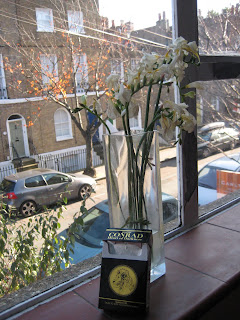History: If you dig deep enough, you can connect the most bizarre and seemingly unrelated bits of historical events together. For example, what connects the Russian military exploits of the 1860s, false rumours of walnut groves in Azerbaijan, oil fields in Baku and Barack Obama? The Nobel prize, of course.
Among the gazillion exhibitions going on in London is one at the
Asia House near Regent’s Park titled “The Nobels and Baku Oil”. As it chronicles, while Alfred Nobel was quietly inventing dynamite in his laboratory in Stockholm, his other less-famous elder brothers, Ludwig and Robert, were busy manufacturing equally innocuous devices such as mines, torpedoes, artillery shells, and weapons in their factory in St. Petersburg to keep the Tzar's army happy. However, they needed – of all things – walnuts to make
gunstocks and walnuts were expensive in St Petersburg. The brothers heard of rumours of walnut groves in Azerbaijan, and Robert was dispatched to investigate more. He never found the walnuts – what he did find was mouth watering oil fields around Baku, the capital of Azerbaijan.
What followed was the making of the Russian Rockfellers, as author
Robert Tolf called the Nobel family, which monopolised the Russian oil production for the next fifty years. In the process, they invented the first oil tankers, and popularised the use of oil pipelines and liquid carrying trains. The fun came to an end with the Russian Revolution, when the Nobels fled Baku and their assets were nationalised. But not before, Alfred Nobel had made another fortune through the oil production company Branobel run by his brothers. Apparently, nearly 12 per cent of his endowment of 33, 200,000 Swedish Krona for the Nobel Prize came from his shares in Branobel.
The multimedia exhibition is a mix of personal histories of the Nobel brothers, the innovations made by them, and lots and lots of oil trivia (if that is what interests you). It has been put together by Azarbaijani historians Azada Huseynova, Naida Abbasova and Amina Malikova, and one can sense that by bringing the Nobel connection to light, they also hope to show the prominent role played by Baku in Europe of the nineteenth century. Many of the sepia photographs show Baku of the times, with wide tree-lined roads, horse carriages and imposing stone buildings. It wasn’t just some remote outpost in the back of the beyond – it was important, it was cosmopolitan, and it was where the action was, or so suggests the exhibition.
Hundred and thirty six years after Robert Nobel arrived in Baku with walnuts in his eyes, Azerbaijan wants these noble connections to be recognised.
***
"The Nobels & Baku Oil" ends tomorrow, and will move on to Berlin, Belgium, Sweden and Norway. But for similar thrilling exhibitions, contact Asia House, 63 New Cavendish Street, London W1G 7LP. (+44 (0)20 7307 5454).
For more on Nobels and Baku Oil, read
Brita Asbrink or
Robert W. Tolf.
 Visited White Cube Gallery at Hoxton Square and Mason’s Yard to see Damien Hirst’s latest exhibition – Nothing Matters.
Visited White Cube Gallery at Hoxton Square and Mason’s Yard to see Damien Hirst’s latest exhibition – Nothing Matters. 






